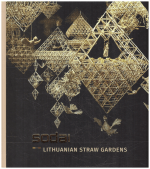Sodai. Lithuanian straw gardens – Marija Liugienė
Neturime
Pranešti el. paštu, kai vėl bus sandėlyje
Aprašymas
Knygoje skelbiami straipsniai akcentuoja šio vizualaus artefakto svarbą ir yra skirti sodų tyrinėjimui, jų simbolikos genezei. Leidinyje atskleidžiami įvairūs simbolikos aspektai vietiniame ir tarpkultūriniame bei tautinių raštų kontekstuose, apmąstoma jų genezė, raida, sukūrimo aplinkybės. Knygos autoriai įvairiai interpretuoja jų istoriją ir simboliką – straipsniai tarsi organiškai išauga vienas iš kito, tačiau kiekvienas pateikia vis naujus tekstus.
Knyga gausiai iliustruota sodų pavyzdžiais, joje pateikiama ir sodo rišimo schema.
Straw gardens represent one of the Lithuanian traditional art forms. Their volume decorations of precise geometric forms carry aesthetic and sacral functions. The most usual forms are of four-side pyramid and other derivative intrinsic structures as well as stars and spheres. The octahedron makes the most common shape, which is, double pyramids whose bases are squares of the same perimeters and whose tops face upwards and downwards. The gardens are decorated with traditional elements symbolising life, fertility and wellbeing. The straw gardens represent an important part of the Lithuanian and Baltic cultural heritage reflecting the old worldview, therefore, they are compared to the World Tree – the universal symbol of harmonious universe: the vertical axis represents the model of the Heavens–the Earth–the Underground or the Past–the Present– the Future, and the horizontal axis stands for the cardinal points.
Norėdami parašyti atsiliepimą, turite prisijungti.






Atsiliepimai
Atsiliepimų dar nėra.